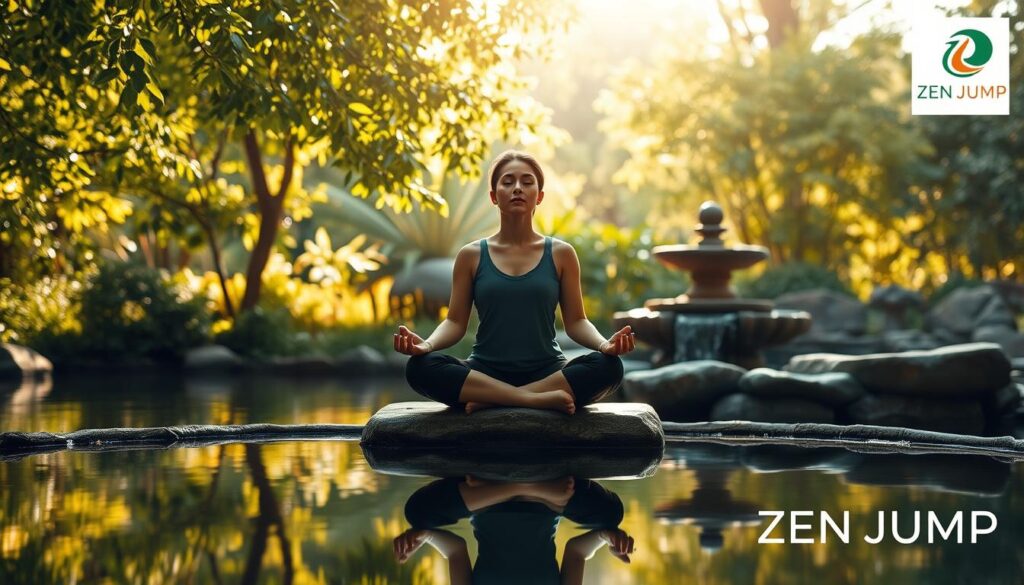Have you ever felt your mind racing between past regrets and future worries? You’re not alone. A striking 70% of people spend too much time thinking about the past or worrying about the future. In our always-connected world, finding inner peace seems like finding a quiet spot in a crowded place.
The notifications buzz, deadlines loom, and the news cycle never stops. Yet, in this chaos, there’s a chance for tranquility.
Inner peace isn’t just for monks on mountaintops. It’s a way of being that we can all learn. When we find true inner peace, we face life’s challenges with calmness, not being swayed by every emotion or event.
Studies show that those who practice mindfulness see a 60% drop in anxiety and a big boost in peace.
This journey to tranquility starts with small steps. Simple practices like breathwork can cut stress by up to 40%. Creating a quiet space at home can make us feel relaxed by nearly the same amount.
The path to inner peace isn’t about escaping reality. It’s about learning to meet life as it is, with an open heart and steady mind.
Key Takeaways
- 70% of people spend excessive time ruminating on the past or worrying about the future
- Breathwork practices can reduce stress levels by up to 40%
- Mindfulness meditation decreases perceived stress and anxiety by 30%
- Creating a quiet space at home increases feelings of relaxation by 40%
- 60% of mindfulness practitioners report decreased anxiety and increased peace
- Inner peace is accessible to everyone through consistent, simple practices
Understanding Inner Peace and Its Importance
Inner peace is more than just feeling calm during meditation or yoga. It’s a lasting sense of serenity that stays with us, even when life gets tough. True inner peace is not a goal we reach but a continuous journey of emotional balance.
What is Inner Peace?
Inner peace is about feeling calm and comfortable with ourselves, others, and our world. About 85% of people believe accepting ourselves as we are boosts our emotional strength and peace of mind. It’s not something we just dream of; it’s something we work on every day through our habits and mindful actions.
Inner peace is about staying calm, no matter what’s happening around us. It lets us act with balance, not just react. This balance gives us freedom, allowing us to choose how we respond to life’s challenges.
Inner peace isn’t something you have – it’s something you become. When your actions match who you truly are, peace naturally follows.
Why Inner Peace Matters in Our Lives
Having peace of mind is key to growing as a person. Studies show that those who are kind to themselves feel 65% more emotionally well. Without this, we get stuck in a cycle of stress and reaction.
Inner peace also makes our relationships better and helps us make clearer decisions. It lets us find joy in everyday moments. Giving up unrealistic hopes can make us 40% happier and more content.
Inner peace is the soil where emotional balance and true personal growth can grow. It helps us stay grounded, no matter what life throws our way.
The Impact of Stress on Our Well-Being
Stress is a big part of our lives today, quietly hurting our mental health and balance. About 77% of people feel physical symptoms from stress, and 73% have psychological ones. This problem goes beyond just feeling bad for a while, touching every part of our lives.
Recognizing Stressors
Knowing what stresses us is key to finding peace. Common stressors include work (affecting 60% of adults), money worries, and relationship issues. But there are also internal stressors like wanting to be perfect and being too hard on ourselves.
Many of us get used to stress without realizing it until it’s too late. Doing a simple stress check can show us what’s off. Look for changes in sleep, eating, and muscle tension (seen in 70% of those stressed).
The body keeps the score. What the mind forgets, our physical form remembers through tension, fatigue, and illness.
Short-Term vs. Long-Term Effects
Short-term stress can help us focus and motivate. It’s a survival tool. But long-term stress blocks growth and harms our connections with others.
Chronic stress hurts our bodies in many ways. It raises the risk of depression and anxiety by 25%. It also weakens our immune system, causes digestive issues, and increases heart disease risk.
Stress also damages our relationships. Without managing stress, we can become short-tempered, hurting our bonds with others. Understanding this helps us work on our health and spiritual well-being.
Mindfulness Practices to Cultivate Inner Peace
Finding peace in today’s fast world needs us to focus on the now. Mindfulness is a way to find inner peace that’s open to everyone. Studies show it can cut stress by 30% and boost our happiness.
Introduction to Mindfulness
Mindfulness means fully focusing on what’s happening right now without judgment. It helps us understand we’re not our thoughts or feelings. People who practice it often feel more present in their lives by 70%.
It’s not about clearing our minds. Instead, it’s about being aware of our thoughts. This change helps us see negative thoughts less often, by 30%, with regular practice.
Mindfulness is the aware, balanced acceptance of the present experience. It is opening to or receiving the present moment, pleasant or unpleasant, just as it is, without either clinging to it or rejecting it.
Techniques for Daily Mindfulness
Adding mindfulness to our daily lives can bring peace without taking up too much time. Here are some easy ways to start:
- Mindful breathing: Take three deep breaths when you switch tasks, focusing on the air moving.
- Mindful listening: Listen fully to sounds or conversations without thinking about what to say next.
- Mindful eating: Eat one meal a day without screens, noticing the taste, texture, and nourishment.
- Body scan: Spend five minutes feeling sensations in your body without trying to change them.
Even short mindfulness moments can help us become more aware over time. People in mindfulness programs see a 20% better quality of life after just eight weeks.
The Role of Meditation in Achieving Inner Peace
Meditation is a key to finding peace in our busy lives. It helps us become more aware of ourselves and relaxes our minds and bodies. Studies show it can lower cortisol levels by up to 30%, helping us feel calm.
Different Types of Meditation
Choosing the right meditation style is important for finding peace. Concentration meditation focuses on a single point, like our breath. Body scan meditation helps release muscle tension. Loving-kindness meditation builds compassion for ourselves and others.
Research shows Mindfulness-Based Stress Reduction programs can cut anxiety by about 30%. Even short sessions of 5-10 minutes can lead to personal growth if done regularly.

Tips for New Practitioners
- Start with short 5-minute sessions to build your practice gradually
- Create a dedicated quiet space free from distractions
- Try guided meditations through apps if sitting in silence feels challenging
- Remember that wandering thoughts are normal—gently return focus when distracted
- Practice at the same time daily to establish routine
Meditation’s benefits last beyond the practice itself. It can make our brains better at making decisions and handling emotions. This helps us grow personally as we learn to handle life’s ups and downs.
By making meditation a daily habit, we open doors to lasting peace. This peace changes how we see both tough and happy moments in life.
Connecting with Nature to Find Peace
The natural world offers a deep path to inner peace, known by our ancestors. Research shows nature heals our minds and brings tranquility like nothing else can.
Benefits of Nature on Mental Health
Studies reveal nature reduces stress hormones by up to 20% and anxiety and depression by about 40%. The American Psychological Association says 120 minutes a week in nature boosts mental health.
Being in green spaces increases positive feelings by 50% and cuts down on worries by 71% compared to cities. Nature helps us feel emotionally balanced by activating our parasympathetic nervous system.
Activities to Engage with Nature
Mindfulness in nature boosts both practices. The Japanese tradition of Shinrin-Yoku, or “forest bathing,” is a slow, sensory way to connect with nature.
- Take a mindful nature walk using all five senses to observe your surroundings
- Find water features like lakes or streams for enhanced tranquility (research suggests “blue spaces” may be specially effective)
- Create indoor nature connections with plants, natural sounds, or even nature photography
- Practice grounding by walking barefoot on grass to reconnect with earth’s energy
Even short times in nature can reset our nervous systems. On busy days, just looking at natural scenes or spending five minutes under a tree can improve focus by up to 20%.
Building a Supportive Community
Our journey to inner peace starts within, but grows with others. A supportive community is key for emotional balance and spiritual harmony. Sharing our stories and struggles helps us find comfort, understanding, and a sense of belonging.
Women often face pressure to be selfless, leading to stress and depression. Men are expected to be strong and protective, hiding their feelings. Finding true relationships helps us break free from these expectations, building emotional strength.
Connecting with people who share our values can change us. Joining groups, doing outdoor activities, or spending time with loved ones is powerful. Building a support network not only helps us but also strengthens our community.
FAQ
What is inner peace?
Why is inner peace important in our lives?
How does stress affect our well-being?
What is mindfulness and how can it help cultivate inner peace?
What are the different types of meditation, and how can they help achieve inner peace?
How can connecting with nature help cultivate inner peace?
Why is building a supportive community important for inner peace?
Source Links
- 10 Essential Mindfulness Practices for Cultivating Inner Peace | LifeAt – https://lifeat.io/blog/10-essential-mindfulness-practices-for-cultivating-inner-peace
- How to Protect Your Peace: 8 Simple, Powerful Strategies for Inner Calm – The Simplicity Habit – https://www.thesimplicityhabit.com/how-to-protect-your-peace/
- 12 essential mindfulness practices for cultivating inner peace — Calm Blog – https://www.calm.com/blog/inner-peace
- How to Find Inner Peace in the Chaos (12 Deep Paths) – https://lonerwolf.com/inner-peace/
- Stress Symptoms, Signs, and Causes – HelpGuide.org – https://www.helpguide.org/mental-health/stress/stress-symptoms-signs-and-causes
- A Silent Storm: The Damaging Impact of Stress on Our Personal and Professional Relationships – https://www.proactivepsychology.com.au/a-silent-storm-impact-of-stress-on-our-relationships/
- Mindfulness A Journey to inner peace – https://intermountainhealthcare.org/blogs/mindfulness-a-journey-to-inner-peace
- Your Inner Peace Path: Essential Practices for a Calmer Mind – https://www.lifesjourneyblog.com/your-inner-peace-path-essential-practices-for-a-calmer-mind/
- Mindfulness 101: Your Path to Inner Peace and Clarity – https://medium.com/muktiyoga/mindfulness-101-your-path-to-inner-peace-and-clarity-a59408363252
- Mindfulness Meditation: a Pathway to Inner Peace and Mental Clarity – https://afaeducation.org/blog/mindfulness-meditation-a-pathway-to-inner-peace-and-mental-clarity/
- Mind-Body Connection | How Mental Health Affects Physical Well-Being – https://www.recoveryteam.org/resources/meditation-a-path-to-inner-peace/
- Meditation: A Journey To Inner Peace – The Study IAS 11689 – https://www.thestudyias.com/blogs/meditation-a-journey-to-inner-peace/
- The Nature Connection: Finding Peace and Perspective – https://www.lettheverseflow.com/natural-connection/
- Thousand Islands Life, Finding Peace in Nature: The Path to Mental Well-Being – https://thousandislandslife.com/finding-peace-in-nature-the-path-to-mental-well-being/
- How To Find Inner Peace In Nature And Be Happy – https://suburbantourist.ca/lifestyle/life/find-inner-peace-nature/
- 4 Superpowers For Finding Greater Inner Peace And Contentment. – https://bevjanisch.com/finding-inner-peace/
- 8 Ways to Embrace Inner Peace — Christina Grant, PhD – https://www.christinagrant.com/blog/embracing-inner-peace-in-chaotic-times
- Self-Care for Inner Peace – The Wellness Universe Blog – https://blog.thewellnessuniverse.com/self-care-for-inner-peace/

